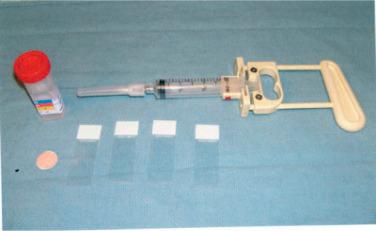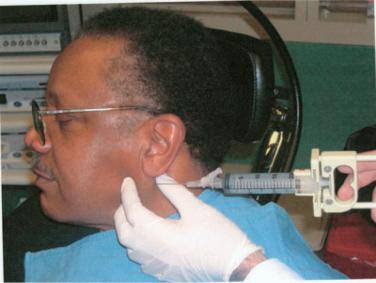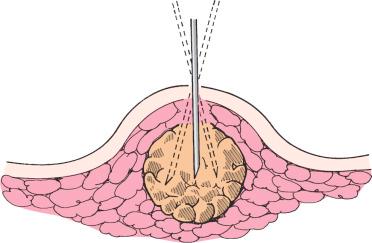Physical Address
304 North Cardinal St.
Dorchester Center, MA 02124
Anatomy
Indications
Technique
From Myers EN: Operative Otolaryngology: Head and Neck Surgery, 2nd Edition (Saunders 2008)
Fine-needle aspiration biopsy (FNAB) has become a standard technique in the initial office evaluation of a mass in the head and neck. These masses encompass a variety of benign and malignant tumors and tumor-like conditions that may present diagnostic challenges to the surgeon and surgical pathologist. The high diagnostic accuracy of this technique makes it an attractive alternative to traditional surgical biopsy. FNAB is particularly useful in sampling a mass in the salivary gland, identification of classic papillary carcinoma and medullary carcinoma of the thyroid, differentiation of colloid goiter from follicular neoplasms, and confirmation of clinically suspicious lymph node metastases in patients with documented or suspected malignant disease.
Needle biopsy has been practiced for more than 100 years and was popularized in the late 1920s by Dr. Hayes Martin at Memorial Sloan-Kettering Hospital. However, he used large-bore needles under local anesthesia, and the technique did not enjoy widespread use in the United States until fine-bore needles were introduced. In this technique a fine-bore needle is introduced into the mass under local anesthesia, cellular material is aspirated, and a cytologic diagnosis is rendered. Until recently, pathologists were reluctant to diagnose malignancies on cytologic preparations. This technique reliably differentiates reactive and inflammatory processes that do not require surgical intervention from neoplasia and benign from malignant tumors. Thus, FNAB lends itself to the diagnosis of a palpable mass in the head and neck, in particular, those that persist after antibiotic treatment.
FNAB is safe, accurate, and cost-effective with minimal complications and great patient acceptance. The diagnosis is able to be known by the clinician before surgery, and treatment modalities can then be planned and discussed with the patient. Rates of false-negative and false-positive diagnosis are low, and the accuracy of detecting malignant lesions is high. If the aspirate is nondiagnostic (which occurs in approximately 10% of cases, usually because of insufficient material), FNAB should be repeated or excision considered if clinically indicated. A negative diagnosis does not rule out malignancy, and if there is any suspicion of malignancy, it may be necessary to repeat the FNAB or perform an open biopsy of the mass. Recent large studies have indicated high sensitivity and specificity for diagnostic evaluation of both epithelial and lymphoid malignancies, thus enabling appropriate planning for staging and therapeutic purposes. Its overall diagnostic accuracy is approximately 95% for all masses in the head and neck, including 95% for benign lesions and 87% for malignant ones.
In the case of lymphadenopathy, FNAB is the first step in evaluation, and a specific diagnosis is obtained 82% to 96% of the time. FNAB is especially useful in the diagnosis of recurrent or metastatic tumors developing in previously irradiated areas. Although the value of the test for metastatic carcinoma and recurrent lymphoma is accepted, its value in the initial diagnosis of lymphoma remains controversial. With the advent of sophisticated cellular immunologic methods such as flow cytometry, characterization of different cellular subsets within the aspirate population can be achieved by staining for surface markers with fluorescent antibodies. Collection of a least two needle passes in Hanks' basic salt solution or Roswell Park Memorial Institute (RPMI) medium for immunophenotyping by flow cytometry addresses some of the concerns with the adequacy of FNAB specimens. Immunophenotyping by flow cytometry detects cell surface antigens with a variety of monoclonal antibodies that indicate differentiation, lineage (B or T cells), and whether there is monoclonal production of light chains or heavy chains. Immunophenotyping also confirms the reactive nature of the lymph node because there will be a polyclonal pattern of immunoglobulins with the production of both light chains in a 2 : 1 κ : λ ratio. Gene rearrangement studies can be performed when the results of immunophenotyping are equivocal, and this has led to a substantial increase in accuracy for typing lymphomas. These are the genes for cell surface antigen receptors, and arrangement of these genes is the earliest genetic event in the development of lymphomas. The gene rearrangement can be detected by Southern blot technique or polymerase chain reaction. Even if open biopsy of a lymph node has to be performed after FNAB, reactive, inflammatory, and metastatic lesions have been eliminated and the diagnostic possibilities are narrowed down.
A negative diagnosis must be evaluated in light of the clinical context because false-negative results occur and a negative FNAB diagnosis does not rule out lymphoma. If the index of suspicion is high or if the lymph node remains the same size or enlarges, excisional biopsy should be considered. Forty-five percent of non-Hodgkin's lymphomas, such as large cell, immunoblastic, small noncleaved, and lymphoblastic lymphoma, can be diagnosed by cytomorphologic examination alone. Diagnostic accuracy is high – 90% to 96% for metastatic carcinoma and 80% to 90% for lymphomas.
Lymph node aspirates in children are more likely to be reactive or inflammatory. FNAB can be performed in children, but if the child is younger than 2 to 3 years, immobilization may be necessary. Sedation can be used in children between 2 and 7 years of age. Children older than this are usually sufficiently cooperative for FNAB to be performed without sedation or other anesthetic techniques. If concern for patient cooperation or safety exists, however, it is certainly possible to perform the procedure under a brief general anesthetic. If an inflammatory process is suspected or if purulent material is aspirated, the specimen should be triaged for microbiologic studies. In addition, special stains can be performed on the cytologic smears. Mycobacteria appear as negative images on a Diff-Quik–stained smear, and an acid-fast stain reveals the typical beaded organisms. Culture or polymerase chain reaction to confirm the type of mycobacteria is also essential.
Although patients may occasionally be apprehensive initially, there are no significant medical contraindications to the FNAB procedure. A small hematoma may occur at times, but significant bleeding such as might compromise the airway is extremely uncommon. A pulsatile mass in the neck may represent the carotid bulb or a carotid body tumor, and many surgeons prefer to not aspirate the latter. However, the use of a fine-gauge needle substantially reduces the chance of complications developing, particularly if the mass can be compressed by manual, external pressure. Cancer seeding through the needle track was previously a concern, but this appears to be more likely with large-bore needles.
In the event of previously insufficient specimens, FNAB can be performed by the pathologist or with a cytopathologist nearby for real-time qualitative and quantitative evaluation of specimen adequacy. The advantages are that assessment of specimen adequacy can be performed and additional needle passes made if sufficient material is not aspirated on the first few passes. This reduces the number of unsatisfactory specimens. Depending on the initial diagnostic impression, the specimen can be triaged appropriately. In many institutions aspiration is performed in offices by clinicians who may not have immediate access to a pathologist to perform the aspiration or even to assess adequacy of the sample. In these circumstances, a minimum of four separate needle passes and preparation of smears of good quality produce optimal specimens for interpretation. In any case, good communication with the pathologist who is interpreting the results of FNAB is of utmost importance. Correlation of the cytologic diagnosis with histopathologic findings in the surgical specimen aids in developing a level of comfort with the pathologist's cytologic interpretation. In patients with thyroid follicular lesions, only examination of multiple sections of the excised nodule can establish or exclude the presence of vascular or capsular invasion, findings that are necessary for distinguishing follicular adenoma from follicular carcinoma. Although this schema was designed for thyroid cytologic analysis at the University of Pittsburgh, it may be applicable to other types of masses.
The following equipment is used ( Figure 88-1-1 ): 20-mL syringes; an optional syringe holder; glass slides with the patient's name written on the frosted end; 1- to ![]() -inch, 21- to 25-gauge needles; 95% alcohol or a spray fixative to fix the slides; alcohol swabs and gauze pads; and a balanced salt solution for rinsing the needle.
-inch, 21- to 25-gauge needles; 95% alcohol or a spray fixative to fix the slides; alcohol swabs and gauze pads; and a balanced salt solution for rinsing the needle.

In the preparatory phase a clinical history is obtained, a directed physical examination is performed, and informed consent may be obtained. The patient is positioned comfortably ( Figure 88-1-2 ). In the case of thyroid aspiration, the neck is extended with a pillow under the shoulders. The person performing the aspiration may be more comfortable standing on the side opposite the mass. Often, the aspirator and the interpreter are two different persons, and clear communication between the two is vital. Thus, it is essential that the pertinent clinical history be documented on the requisition form including previous attempts at biopsy and previous treatments. The number of needle passes, along with a gross description of the aspirate, can be documented on the form. In addition, in the event that a cystic mass is aspirated, the volume of fluid that was removed from the mass should be recorded. The syringe containing this material should be sent to cytopathology to be “spun down” and made into a cell block for paraffin embedding and microscopic examination.

A syringe with 1 mL of air in it is placed in the optional syringe holder. The area is cleaned with an alcohol swab. Because of the fine bore of the needle, local anesthesia is optional and most patients tolerate the procedure well. However, we infiltrate the biopsy site with 1% lidocaine with a 1 : 100,000 dilution of epinephrine. The mass is fixed between two fingers of the nondominant hand, and the skin is stretched slightly to reduce pain. The needle is introduced into the mass. Vacuum is created by pulling back on the plunger of the syringe. In the case of thyroid aspiration, the patient is advised to not swallow while the needle is in the mass. The needle is moved in and out of the mass in short vibratory strokes for a distance of 2 to 3 mm ( Figure 88-1-3 ). It is important that the direction of the needle not be changed while it is in the mass. Significant manipulation of the needle within the mass can lead to disruption of blood vessels, which increases the morbidity of the procedure and compromises the quality of the specimen. As soon as material enters the hub of the needle, the vacuum is released, the needle is removed from the mass, and pressure is applied to stop bleeding.

The aspiration technique in thyroid nodules in children can be alternated with a nonaspiration technique. The needle is introduced without an attached syringe or without suction in the syringe. If a cyst is suspected, the syringe may be attached with the plunger removed. For thyroid lesions or those that yield bloody specimens, needle passes without the application of negative pressure are sometimes useful, and sufficient cellular material can be introduced into the needle hub for cytopathologic analysis. The needle is moved in and out of the mass in short vibratory strokes, and the needle may be rotated. After 15 to 20 strokes, the needle is withdrawn and pressure applied. The material is expelled onto slides after attaching a syringe. A minimum of four separate needle passes is made.
The aspirated material is expelled onto two slides, with the beveled edge of the needle touching the slides, which have previously been labeled with the patient's name. Smears are prepared by placing the surfaces of the two slides containing the specimen against each other and drawing one slide along the long axis of the other. One smear may be air-dried and the other one immediately wet-fixed in 95% ethyl alcohol, or the slide may be spray-fixed from a distance of 8 to 10 inches. The needle is then rinsed in a balanced salt solution. Normal saline is not recommended because it is not physiologic. The specimen may be specified for microbiologic studies or sent for immunophenotyping by flow cytometry. Every effort should be made to have the slide processed and read immediately while the patient is still in the office. If the FNAB is unsatisfactory, it can be repeated without the need for the patient to return another day.
Recently, ultrasound-guided FNAB has gained acceptance in the surgeon's office. This technique is particularly useful in detecting metastatic or recurrent disease in known cases of malignancy or in localizing masses in the third dimension for obtaining a cytopathologic specimen. Advantages include improved specimen quantity and quality, as well as reduced waiting times by avoiding delay caused by scheduling a procedure in the radiology suite.
In any cystic lesion of the neck, a rule of thumb is to empty the cyst and aspirate any residual mass or the capsule of the cyst to avoid missing a cystic carcinoma. Occasionally, computed tomography–guided FNAB may be necessary to specifically sample a solid-appearing mural nodule in a cyst that is not palpable in the office. Usually, however, cystic mass aspirates can be adequately diagnosed by an experienced cytopathologist. The differential diagnosis of cystic lesions in the neck is quite extensive and includes benign cysts such as branchial cleft cysts, thyroid and thyroglossal cysts, parathyroid cysts, and Warthin's tumor. Malignant cystic lesions include papillary carcinoma of the thyroid, mucoepidermoid carcinoma of the parotid gland, and cystic squamous carcinoma metastatic to a lymph node.
FNAB is also indicated for the diagnosis of parotid masses because open or large-bore needle biopsy may traumatize the facial nerve or produce tumor seeding of the skin and soft tissue with the risk of recurrent disease. Many lesions thought to be neoplasms on clinical examination are often intraparotid lymph nodes, localized sialadenitis, benign lymphoepithelial lesions, or cysts. FNAB diagnosis of a lymphoepithelial lesion or lymphoma of the parotid gland in patients with acquired immunodeficiency syndrome averts surgery in this group of high-risk patients. FNAB of salivary glands is up to 90% accurate and is better for diagnosing benign than malignant tumors. FNAB has a sensitivity of 90% and a specificity of 80% for the salivary glands. False-positive rates in different series have varied from 0% to 4.7%.
In summary, FNAB is a highly useful technique in the algorithm for office-based evaluation of cervical masses. There should be good communication between the clinician and the cytopathologist, with both working as a team, which will lead to an optimal cytologic diagnosis and result in good patient care. FNAB of a mass in the head and neck is an optimal way to make a diagnosis, and in the present managed care environment, it is an ideal technique for making a diagnosis in a quick and cost-effective manner.
The ability to discriminate benign from malignant cervical masses, rapid assessment, potential avoidance of surgical intervention, low complication rates, and cost-effectiveness have made FNAB diagnosis of head and neck masses the standard of care.
FNAB for thyroid follicular lesions cannot differentiate benign from malignant neoplasms.
A cystic nodule in the lateral aspect of the neck demonstrating numerous proliferating squamous cells raises the possibility of metastatic papillary carcinoma of the thyroid or metastatic squamous cell carcinoma, usually from the base of the tongue or tonsil.
Exposure of cytology slides to air for prolonged periods before fixation leads to air-drying artifact, which limits the quality of the specimen.
Using high suction (negative pressure) in the syringe will predispose to bloody cytologic specimens that can be difficult for the cytopathologist to interpret.
A single negative FNAB should not be overweighted in the context of other suspicious clinical data, and concern for malignancy should prompt further cytologic or histologic analysis of the mass in the neck.
Become a Clinical Tree membership for Full access and enjoy Unlimited articles
If you are a member. Log in here